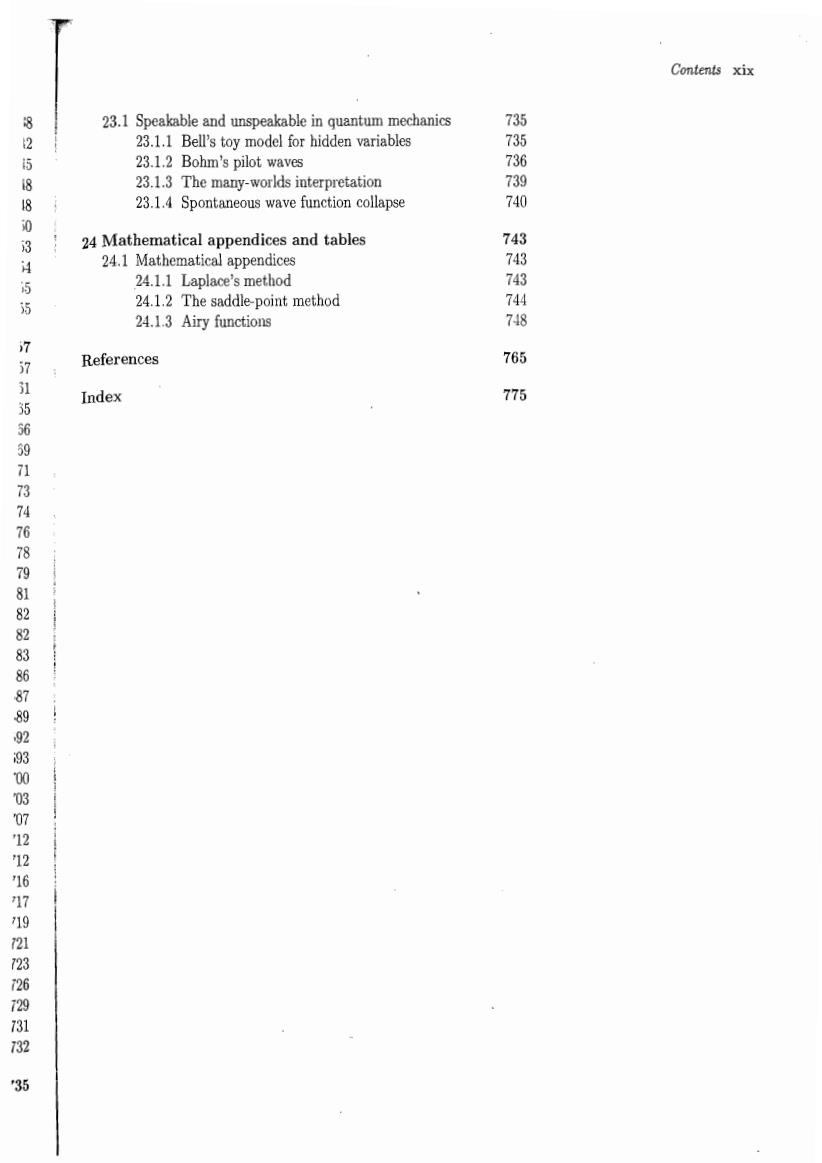
xvii Contents 21.4.4 Asymptotic series 638 23 21.4.5 The dispersion relation 642 21.4.6 The perturbative-variational approach 645 21.5 The semi-classical approximation in general systems 648 21.5.1 Introduction 648 215.2 Keller quantization 650 21.5.3 Integrable systems 653 2A 2154Fx 215.6 The KAM theorem and quantization 22S lements for Part III system and CP violatior Refe el de s女y Inde 22.2.2g(E)and the partition function 666 22.2.3g(E)and short-distance behavior 22.2.4 Level density and scattering 6 22.2.5 The stabilization method 22.3 Thomas precession 674 22.4 Relativistic corrections in an external field 676 22.5 The Hamiltonian for interacting charged particles 678 679 22.5.2 Spin-dependent i 631 um Hamilto tera ueus interaction 22.5.6 The 1/M corrections 22.6 Quantization of electromagnetic fields 687 22.6.1 Matrix elements 689 22.7 Atoms 22.7.1 The Thomas-Fermi approximation 693 22.7.2 The Hartree approximation 700 22.7.Slater matrix elements 703 22.7.4 Hamiltonians for closed shells 707 22 75 Mean 712 s for incomplete shells The elementary theory of multiplet 22.7.9 The Hartree -Fock equations 22.7.10The role of Lagrange multipliers 721 22.7.11Koopman's theorem 723 22.8H时 726 22.9 The Gross-Pitaevski equation 729 22.10 The semi-classical scattering amplitude 731 22.10.1 Caustics and rainbov 732 23 Supplements for Part IV 735

Contents xix 23.1 Speakable and unspeakable in quantum mechanics 的 23.1.1 Bell's toy model for hidden variables 8258803455 23.1.2 Bohm's pilot waves 23.1.3 The many-worlds interpretation 23.1.4 Spontaneous wave fur tion collaps 24 Mathematical appendices and tables 24.1 Mathematical appendices 24.1.1 Laplace's method 24.1.2 The saddle-point method 24.13 Airy functions 1653030245 7 57 References Index 75 5973240898828868908000000012267722302

Part I Basic quantum mechanics

Basic quantum mechanics 3 Part I of this book introduces the basic concepts of quantum mechan- ics.from the fundamental laws and the main postulates of quantum mechs,simple applications in one-dimensiona systems,and angula mentum,to simple three-dimensional systems and some finer points of thequan mchaic Feyn'ph-egra oo of mechanics is introduced

Introduction 1 Physical phenomena in the microscopic world are extraordinary and of- ten appear even paradoxical from the viewpoint of our daily experiences. 5 of int this 1.2T on qua s a tew si Further reading 18 ron.We then briefly revi Guide to the Supplements 18 the discovery of quantum mechanics. Problem Numerical analyses 1919 1.1 The quantum behavior of the electron The examples chosen are the diffraction and interference,the stability and identity of atoms(of the same kind),and the tunneling phenomenon. 1.1.1 Diffraction and interference-visualizing the quantum world Two of the most of the electro are diffraction and interference,both of which are typical features of Fig.1.1 A typical interference fringe a wave. As is well known,light is a wave,a propagating wave of in Young's experiment electromagnetic fields,and as such,exhibits all phenomena typical of waves,such as interference and diffraction.Consider as an example the famous double-slit experiment a la Young (1801).The typical interfer- ence fringes between the light beams which go through two different slits look like Fig.1.1.If the distance between the two slits,the distance be- tween the double slits and the screen,and the vertical position on the screen are d,L,and respectively (see Fig.1.2),the diffraction angle Thus for light of wavelength the condition for constructive or de structive interference is Ad Pig.1.2 A schematic view of Young's =n or experiment. n=0,1,2… respectively. In the experiment of Fig.1.1,L/d10A=10-5cm,so the inter-frine gap is of the order of.1mm